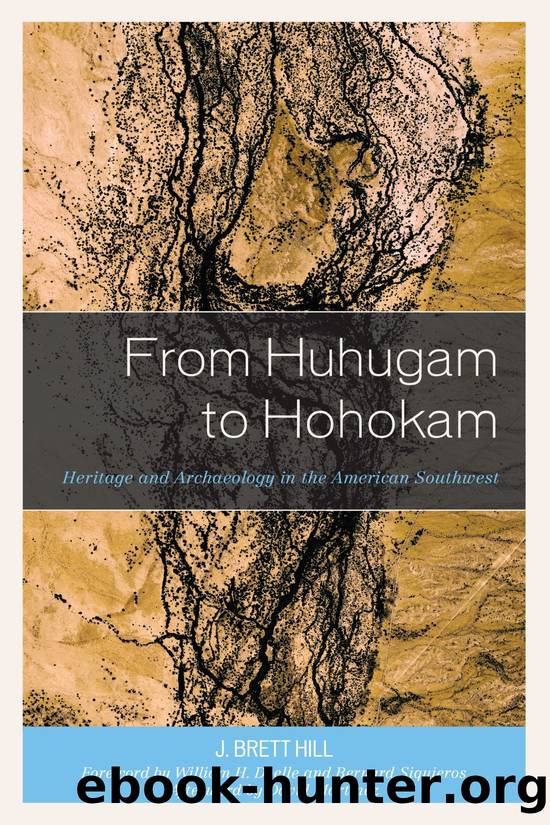From Huhugam to Hohokam by Hill J. Brett;Doelle William H.;Martínez David.;Siquieros Bernard;

Author:Hill, J. Brett;Doelle, William H.;Martínez, David.;Siquieros, Bernard;
Language: eng
Format: epub
Publisher: Lexington Books/Fortress Academic
Chapter 6
The First Anthropologists
Anthropology emerged as a distinct scientific discipline in the late 1800s, and Native Americans, past and present, became a popular subject for new theories of human culture. Unlike earlier generations who came to spread religion or political authority, new scholars of culture came to southern Arizona for archaeology, excavating and recording the ruins found there. This focus on ancient materials produced voluminous descriptions of every kind of artifact and feature. But it sometimes did so at the expense of interest in living people. The people living in the region had long been distinguished in a remarkable diversity of culture groups, but now they were more clearly distinguished from the builders of the ruins. The advent of scientific archaeology is marked by a subdivision of the past into its own set of categories and their systematic comparison.
Those early anthropologists shared some qualities with the explorers in the last chapter, including a colonial approach to the region and its people. They perceived themselves as taking control of the land and anything found to be valuable. They did not consider the possibility of Native ownership of ruins, artifacts, or human remains. When the first archaeologists rode into the Salt River Valley in the 1880s, they asked permission only from the white farmers within whose fields they wished to excavate.
In other ways, though, anthropologists bring a new orientation to the Sonoran Desert. They mostly come from academic institutions in the eastern United States, and they bring academic questions and tools to address them. They divide the material they find for comparative analysis, drawing ever more specific conclusions. They increasingly organize their analysis on principles of dualism, drawing distinctions that are still fundamental to archaeology today. Moreover, they begin to establish theories for the presence and absence of different populations in ecological terms, as part of the natural environment and subject to natural explanations. The period was marked by great concern over the loss of Native culture and the deterioration of ruins. Salvage ethnography commenced to save the former. The establishment of Casa Grande as the first archaeological national monument in the United States helped to preserve the ruins.
These populations needed names, and scholars borrowed freely from historical and ethnographic literature for them, but with little regard for earlier meanings. The term Hohokam emerges as one of these that is quickly reduced to a variable equated with material culture styles, its meaning manipulated and inverted. As quickly as Hohokam is scientifically established, it is contrasted with others, especially the Salado. From the beginning, though, anthropologists struggled with crosscutting distinctions that eluded easy classification. Some of them proposed sophisticated and nuanced ideas that resonate as sensible today, but others proposed strange interpretations and leaps of logic.
An unfortunate trend throughout this period was a diminishing respect for Oâodham accounts of the past. The first anthropologists asked local people about the ruins, but over time scholars marginalized Native interest in and knowledge of the past, as scientific categories were elevated instead. Though many acknowledged the
Download
This site does not store any files on its server. We only index and link to content provided by other sites. Please contact the content providers to delete copyright contents if any and email us, we'll remove relevant links or contents immediately.
| United States |
In Cold Blood by Truman Capote(2702)
Steve Jobs by Walter Isaacson(2459)
All the President's Men by Carl Bernstein & Bob Woodward(1973)
Lonely Planet New York City by Lonely Planet(1857)
The Murder of Marilyn Monroe by Jay Margolis(1752)
The Room Where It Happened by John Bolton;(1729)
The Poisoner's Handbook by Deborah Blum(1672)
And the Band Played On by Randy Shilts(1632)
Lincoln by David Herbert Donald(1622)
The Innovators by Walter Isaacson(1612)
A Colony in a Nation by Chris Hayes(1531)
The Innovators: How a Group of Hackers, Geniuses, and Geeks Created the Digital Revolution by Walter Isaacson(1519)
Under the Banner of Heaven: A Story of Violent Faith by Jon Krakauer(1426)
The Unsettlers by Mark Sundeen(1347)
Amelia Earhart by Doris L. Rich(1346)
Birdmen by Lawrence Goldstone(1346)
Decision Points by George W. Bush(1261)
Dirt by Bill Buford(1247)
Zeitoun by Dave Eggers(1232)
